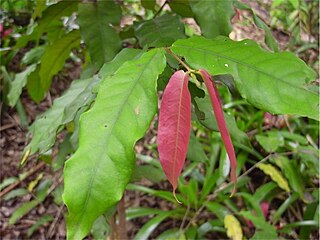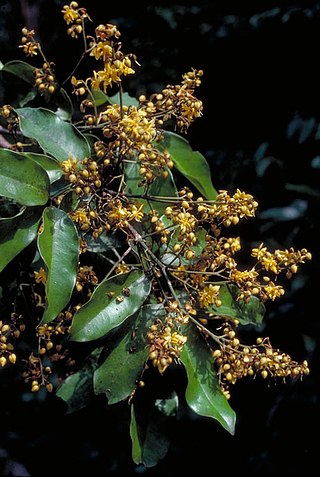
Sankowskya is a genus of plants. The sole known species, Sankowskya stipularis, is a tree endemic to one locality in the Wet Tropics rainforests of northeastern Queensland, Australia. The species constitutes part of the plant family Picrodendraceae. Few botanical collections have ever been made of the trees, from a very restricted area of the Wet Tropics rainforests, hence the species has obtained the conservation status of "endangered" in the legislative regulation of the Queensland Government's Nature Conservation Act 1992. Notably, trees grow naturally in the Thylogale Nature Refuge.

Cupaniopsis is a genus of about 67 species of trees and shrubs of the soapberry family, Sapindaceae. They grow naturally in New Guinea, New Caledonia, Australia, Torres Strait Islands, Fiji, Samoa, Sulawesi, Micronesia. Many species have been threatened with extinction globally or nationally, with official recognition by the International Union for Conservation of Nature (IUCN) and several national and state governments.
Pilidiostigma is a genus of shrubs and small trees in the myrtle family Myrtaceae. All species occur in Australia and one, P. papuanum, also occurs in Papua New Guinea. They are not generally known to horticulture. The species P. sessile is rare.

Diploglottis is a genus of 10 species of trees known to science, constituting part of the plant family Sapindaceae. They grow naturally in rainforests and margins of adjoining humid forests in eastern Australia and New Guinea. Some species are known as native tamarind or small-leaved tamarind; they have no direct relationship with the true tamarind.

Atalaya is a genus of eighteen species of trees and shrubs of the plant family Sapindaceae. As of 2013 fourteen species grow naturally in Australia and in neighbouring New Guinea only one endemic species is known to science. Three species are known growing naturally in southern Africa, including two species endemic to South Africa and one species in South Africa, Eswatini and Mozambique.

Lepiderema is a genus of nine species of trees from the family Sapindaceae. As of November 2013 botanists know of seven species growing naturally in Australia and two species in New Guinea. Published botanical science provides a limited knowledge of the full range of diversity in Australia and especially in New Guinea. In New Guinea the two known species have descriptions based each on only a single type specimen collection. Therefore, collection of more specimens and more species is most likely in New Guinea. In Australia they grow in rainforests of the northern half of the east coast side of the Great Dividing Range, from northeastern New South Wales through to northeastern Queensland.

Pseuduvaria is a genus of the plant family Annonaceae and tribe Miliuseae: with a native range is Tropical Asia.

Elaeocarpus obovatus, commonly known as hard quandong, blueberry ash, whitewood, grey carabeen, freckled oliveberry or gray carrobeen, is a species of flowering plant in the family Elaeocarpaceae and is endemic to eastern Australia. It is a tree with buttress roots at the base of the trunk, egg-shaped to lance-shaped leaves with the narrower end towards the base, racemes of white flowers, and blue, oval fruit.

Storckiella australiensis is a species of large rainforest legume trees up to 35 m (115 ft) tall, constituting part of the plant family Fabaceae. It has the common name white bean.
Hollandaea is a small genus of plants in the family Proteaceae containing four species of Australian rainforest trees. All four species are endemic to restricted areas of the Wet Tropics of northeast Queensland.

Aceratium is a genus of about 20 species of trees and shrubs of eastern Malesia and Australasia from the family Elaeocarpaceae. In Australia they are commonly known as carabeens. They grow naturally in rainforests, as large shrubs to understorey trees and large trees.

Mischarytera is a genus of rainforest trees, constituting part of the plant family Sapindaceae. Four species are known to science as of December 2013, found growing naturally in eastern Queensland, Australia, and in New Guinea. Formerly until 1995, they had names within the genus Arytera, subgenus Mischarytera.

Sarcotoechia is a genus of tropical rainforest trees, constituting part of the plant family Sapindaceae.

Synima is a genus of tropical rainforest trees, constituting part of the plant family Sapindaceae.
Cnesmocarpon is a genus of 4 species of rainforest trees known to science, constituting part of the plant family Sapindaceae.
Elaeocarpus johnsonii, commonly known as Kuranda quandong or Johnson's quandong, is species of flowering plant in the family Elaeocarpaceae and is endemic to north-east Queensland. It is a small to medium-sized tree, often with several main stems, elliptic to egg-shaped leaves with the narrower end towards the base, racemes of up to seven flowers, the petals with fringed lobes, and dark blue fruit.
Elaeocarpus largiflorens, commonly known as tropical quandong, is a species of flowering plant in the family Elaeocarpaceae and is endemic to Queensland. It is a medium-sized to large tree, sometimes with buttress roots at the base of the trunk, mostly elliptic leaves and reddish-brown flowers.
Elaeocarpus stellaris is a species of flowering plant in the family Elaeocarpaceae and is endemic to north-eastern Queensland. It is a tree, sometimes with buttress roots at the base of the trunk, elliptic to egg-shaped leaves, small groups of flowers with greenish-yellow sepals and creamy-white petals, the fruit containing a five-flanged stone.
Elaeocarpus thelmae is a species of flowering plant in the family Elaeocarpaceae and is endemic to north-east Queensland. It is a tree, often with buttress roots at the base of the trunk, egg-shaped to elliptic leaves with many hairy domatia, densely rusty-hairy flowers, and blackish, oval fruit.

Peripentadenia phelpsii is a plant in the family Elaeocarpaceae which is endemic to a very small part of northeastern Queensland, Australia. It is a large evergreen tree with large buttresses, and was first described in 1982.













